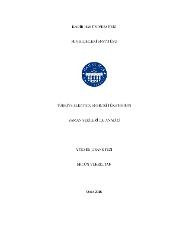| dc.contributor.advisor | Bilge, Ayşe Hümeyra | en_US |
| dc.contributor.author | Yükseltan, Ergün | |
| dc.date.accessioned | 2019-07-12T08:45:42Z | en_US |
| dc.date.available | 2019-07-12T08:45:42Z | en_US |
| dc.date.issued | 2016 | en_US |
| dc.identifier.uri | https://hdl.handle.net/20.500.12469/2634 | |
| dc.description.abstract | Serbestleşen elektrik enerjisi pazarında oluşturulan sistemler sayesinde üreticiler, yapılan tahminler çerçevesinde saatlik üretim planlarını sisteme girmektedirler. Tahminlerin doğruluğu rekabetçi piyasa ve kesintisiz elektrik enerjisi arzı için büyük önem taşımaktadır. Bu sebeple bir çok matematiksel modelleme yöntemi kullanılmaktadır. Bu çalışmada Türkiye elektrik tüketimi, 2012-2014 yıllarına ait saatlik elektrik tüketim datası ile günlük, haftalık, mevsimsellik ve ayrıca sıcaklık sapmaları ile modellenmiştir. Mevcut yıllık periyotlu data %3.94 hata oranı ile modellenmiş ve %9.8 hata oranı ile tahmin sonucu vermiştir (L2 Norm). Ayrıca günlük tüketim eğrileri ve hafta içi-hafta sonu tüketim örnekleri incelenmiş ve elektrik tüketimindeki sanayi bazlı etki açıklanmaya çalışılmıştır. Sıcaklık etkisinin tüketim üzerindeki etkisini daha iyi v görebilmek amacıyla her saat dilimine ait sıcaklık-tüketim eğrileri oluşturulmuştur. Benzer saat dilimlerindeki sıcaklığa bağlı tüketim değerleri hafta sonu ve hafta içi tüketim farklılıkları ele alınarak açıklanmıştır. Oluşturulan bu tüketim eğrilerinden, insanların genel olarak uykuda oldukları süre içerisinde konfor sıcaklığının altındaki sıcaklık değerlerine, konfor sıcaklığının üzerindeki sıcaklık değerlerindeki kadar tepki vermediği görülmüştür. Ayrıca akşam ve gece saatlerinde sıcaklık-tüketim eğrisinin hafta içi ve hafta sonu için büyük oranda benzer olduğu fark edilmiştir. Ek olarak hafta içi gün içerisinde oluşan tüketim eğrilerinin açıkça benzer ve düzgün bir parabolik eğri olduğu görülürken, hafta içi mesai başlangıç ve bitiş saatlerindeki ve hafta sonundaki oluşan tüketim değerleri, insanların çeşitli aktivitelerde bulunması nedeniyle farklı ve düzensizdir. Hafta sonu tüketim eğrilerini kendi içerisinde incelediğimizde ise yine benzer sebeplerden Pazar ve Cumartesi günü tüketim eğrilerinin büyük oranda farklı olduğu görülmüştür. | en_US |
| dc.description.abstract | Turkish power market has undergone a restructuring and deregulation to reach a competitive and reliable electricity market. A typical day starts when the system operator announces the next day demand forecast for the electricity and participants submit offers in response to me et the demand. Accuracy in electricity demand forecast is essential for a reliable power system and successful market operation. Mathematical models are needed to help market participants forecast the electricity demand. We use hourly electricity demand data for Turkey, for the years 2012-2014 to make a linear model taking into account seasonal, weekly and diurnal periodic variations and the deviations from optimal temperatures. The model fits the yearly data within %4 and predicts within %9.8 in the L2 norm. We discuss daily variation curves and the week day/weekend demand profiles as well as demand profiles for holidays to infer the proportion of industrial and domestic electricity AP vii demand. In order to observe clearly effects of temperature on electricity consumption, we formed temperature-consumption curves for each hours. Similar hours were considered together to explain temperature effects on people's behave. We see that people give different reaction to temperature deviation from confrom level when they are in sleep. When temperature is above comfort level, people have much tendency to reach comfort level with using cooling system. However, their reaction is less for temperature lower than comfort level. In addition, during evening and night periods, there is no such a big difference on consumption curves that belong to week and weekend. In week days periods 08:00-18:00 have smilar and more regular curves while in early morning and late in afternoon have different and irregular consumption pattern due to different working hours and activies of people in these hours. Also, weekend days were considered seperately, Sunday has unique consumption pattern. | en_US |
| dc.language.iso | tur | en_US |
| dc.publisher | Kadir Has Üniversitesi | en_US |
| dc.rights | info:eu-repo/semantics/openAccess | en_US |
| dc.subject | Zaman Serileri | en_US |
| dc.subject | Fouirer Serileri | en_US |
| dc.subject | Türkiye Saatlik Enerji Tüketimleri | en_US |
| dc.subject | Elektrik Enerjisi Marketi | en_US |
| dc.subject | Yük Tahmini | en_US |
| dc.subject | Time series analysis | en_US |
| dc.subject | Fourier Series | en_US |
| dc.subject | Hourly Electricity Demand for Turkey | en_US |
| dc.subject | Deregulated Electricity Market | en_US |
| dc.subject | Load Forecast | en_US |
| dc.title | Türkiye elektrik enerjisi tüketimini zaman serileri ile analizi | en_US |
| dc.type | masterThesis | en_US |
| dc.department | Enstitüler, Lisansüstü Eğitim Enstitüsü, Finansal Matematik Ana Bilim Dalı | en_US |
| dc.relation.publicationcategory | Tez | en_US |
| dc.identifier.yoktezid | 422136 | en_US |
















